Potential Invader
May beetle, June bug
Family: Scarabaeidae Subfamily: Melolonthinae Genus: Phyllophaga Species: Phyllophaga ephilida (Say, 1825)
DNA barcode available: specimen information
Total body length 13.0–17.8 mm (0.51–0.70 in). Body shape cylindrical, somewhat elongate. Color reddish-brown. AntennaeAntennae:
paired sensory organ on head, formed from numerous segments
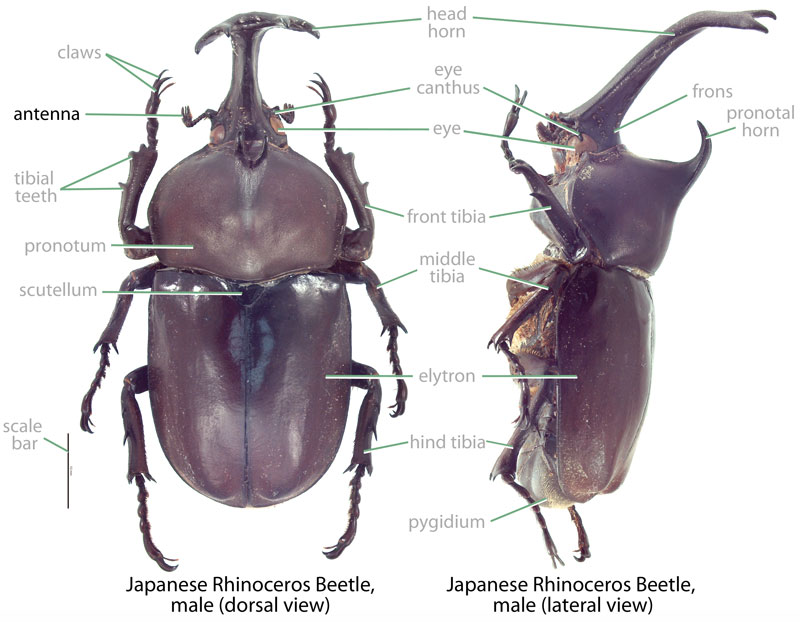 10-segmented; club 3-segmented; male club subequal in size to segments 1-7; female club noticeably shorter than segments 1-7. Clypeusclypeus:
10-segmented; club 3-segmented; male club subequal in size to segments 1-7; female club noticeably shorter than segments 1-7. Clypeusclypeus:
part of the head anterior to the frons; the most anterior portion in dorsal view
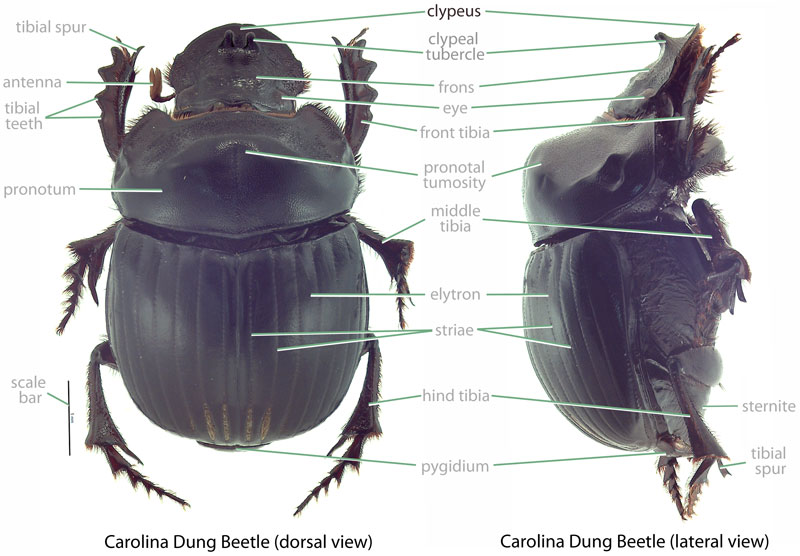 reflexed; sinuatesinuate:
reflexed; sinuatesinuate:
gently curved (specifically of margins or edges); often in reference to the clypeus
. Head lacking ridge at base of fronsfrons:
part of the head generally positioned between the eyes (posterior to the clypeus and anterior to the vertex) and visible dorsally
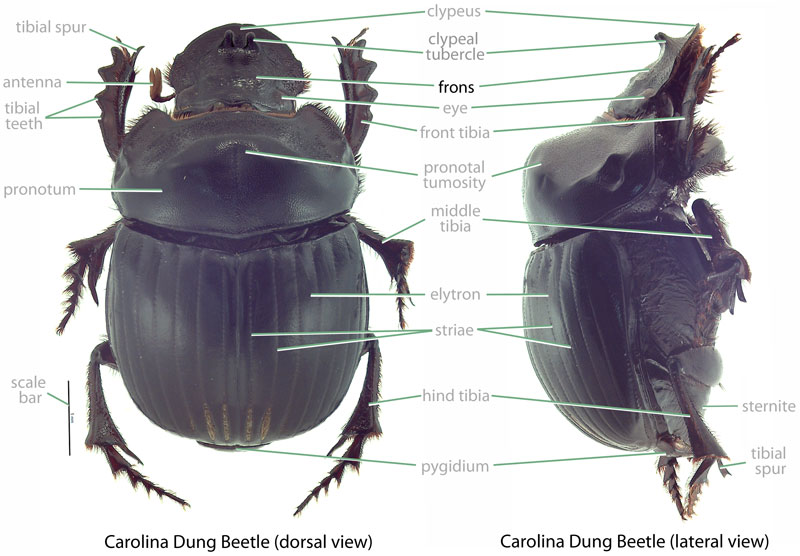 . Pronotumpronotum:
. Pronotumpronotum:
the dorsal surface of the thorax
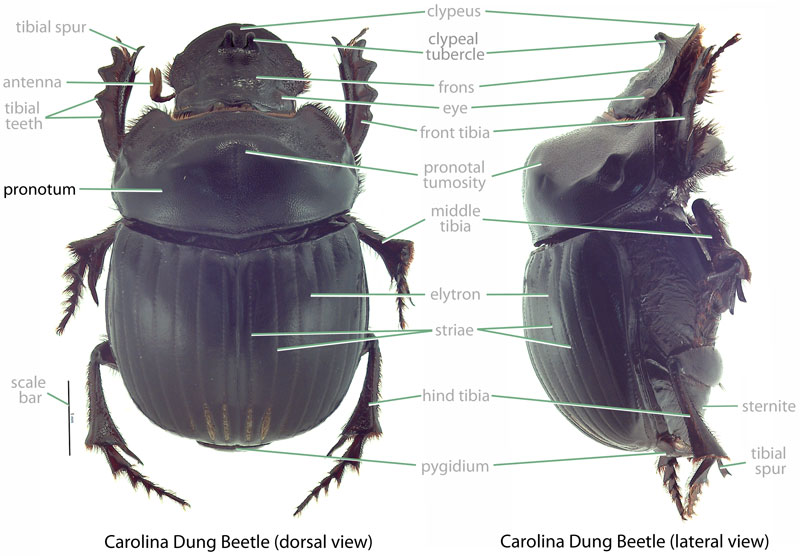 lacking constriction near apical angle; lacking distinct foveafovea:
lacking constriction near apical angle; lacking distinct foveafovea:
a depressed pit or indentation
at each side of anterioranterior:
the front or forward; opposite of posterior
margin in male and female. ElytraElytra:
the hardened and chitinous wing-cover of a beetle that protect and overlie the flight wing
smooth; lacking prominent setaesetae:
small, hair-like structure
.
(Ritcher, 1966Ritcher, 1966:
Ritcher P. 1966. White grubs and their allies: a study of North American scarabaeoid larvae. Oregon State University Monographs, Studies in Entomology 4: 1-219.): Grub C-shaped, not hump-backed, cylindrical, whitish. Maxillamaxilla:
set of paired mouthparts located posterior to the mandibles
with galeagalea:
outer branch or lobe of the maxilla
 and lacinialacinia:
and lacinialacinia:
inner portion of the maxilla fused. Mandiblemandible:
fused. Mandiblemandible:
The crushing or chewing portion of an insects mouthparts
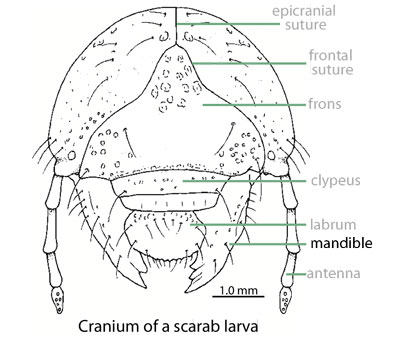 with basolateralbasolateral:
with basolateralbasolateral:
relating to base of the side part/portion
region with 9 setae; dorsoexteriordorsoexterior:
relating to the upper and outer part/portion
region with fewer than 3 setaesetae:
small, hair-like structure
. Epipharynxepipharynx:
lobe on the interior surface of the labrum or clypeus
haptomerum with 11 heliheli:
in scarab larvae, a coarse spine on or near the haptomerum
. Proplegmatiaproplegmatia:
in scarab larvae, an area of folded, parallel ridges before the plegmatium
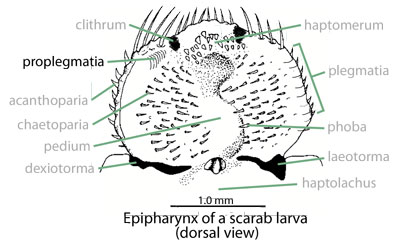 with 7–10 proplegmata. Last antennal segment with single large, oblong, dorsaldorsal:
with 7–10 proplegmata. Last antennal segment with single large, oblong, dorsaldorsal:
of or relating to the upper surface; opposite of ventral
sensory spot. Respiratory plates of spiraclesspiracles:
opening on the abdomen or thorax through which air enters and exits the body
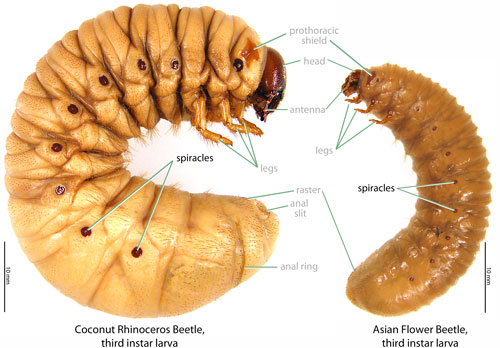 not constricted. Rasterraster:
not constricted. Rasterraster:
in scarab larvae, a complex of setose, spiny, and bare areas on the ventral surface of the last abdominal segment with closely set palidiapalidia:
with closely set palidiapalidia:
paired group(s) of recumbent (reclining) spines, usually occurring in rows; part of the raster
. PaliPali:
in scarab larvae, a straight, pointed spine, particularly as relates to the raster
short, somewhat hooked, less than 3 times as long as the widths of their bases. Anal opening Y-shaped.
Eastern North America. This species is widely distributed across eastern North America, occurring from Nebraska east to New York and south to northeast Texas and Florida (Woodruff and Beck, 1989Woodruff and Beck, 1989:
Woodruff R and Beck B. 1989. The scarab beetles of Florida (Coleoptera: Scarabaeidae) part II. The May or June beetles (genus Phyllophaga ). Arthropods of Florida and Neighboring Land Areas 13: 1-223.).
Adults of Phyllophaga ephilida feed at night on the foliage of a variety of plants: alder (Alnus spp.), apple (Malus spp.), ash (Fraxinus spp.), black walnut (Juglans nigra), hackberry (Celtis occidentalis), pear (Pyrus spp.), pecan (Carya illinoinensis), persimmon (Diospyros spp.), plum (Prunus spp.), red oak (Quercus rubra), river birch (Betula nigra), rose (Rosa spp.), strawberry (Fragaria spp.), water oak (Quercus fastigiata), wild cherry (Prunus avium), willow (Salix spp.), and winged elm (Ulmus alata) (Woodruff and Beck, 1989Woodruff and Beck, 1989:
Woodruff R and Beck B. 1989. The scarab beetles of Florida (Coleoptera: Scarabaeidae) part II. The May or June beetles (genus Phyllophaga ). Arthropods of Florida and Neighboring Land Areas 13: 1-223.). LarvaeLarvae:
the immature form of an insect; in scarabs, also called grub or white grub; preceded by the egg stage, followed by the pupal stage
 are known to damage roots of turf grasses (Watschke et al., 1994Watschke et al., 1994:
are known to damage roots of turf grasses (Watschke et al., 1994Watschke et al., 1994:
Watschke T, Dernoeden P, Shetlar P. 1994. Managing Turfgrass Pests. Boca Raton, FL. CRC Press.) and sweet potato (Ipomoea batatas) (Diagne et al., 2006Diagne et al., 2006:
Diagne A, Story R, Hammond A. 2006. Adult Phyllophaga ephilida host plant feeding preference. Florida Entomologist 89: 391-395. full text (accessed 2015)).
(Woodruff and Beck, 1989Woodruff and Beck, 1989:
Woodruff R and Beck B. 1989. The scarab beetles of Florida (Coleoptera: Scarabaeidae) part II. The May or June beetles (genus Phyllophaga ). Arthropods of Florida and Neighboring Land Areas 13: 1-223.): Adults of this species feed on foliage at night. Adults are active through summer, and females deposit eggs in loose soil near potential host plants. The larvaelarvae:
the immature form of an insect; in scarabs, also called grub or white grub; preceded by the egg stage, followed by the pupal stage
 live in the soil where they feed on the roots of nearby plants, particularly grasses. Overwintering occurs in the larval stage. LarvaeLarvae:
live in the soil where they feed on the roots of nearby plants, particularly grasses. Overwintering occurs in the larval stage. LarvaeLarvae:
the immature form of an insect; in scarabs, also called grub or white grub; preceded by the egg stage, followed by the pupal stage
 take between one to three years to develop into adults (dependent upon location).
take between one to three years to develop into adults (dependent upon location).
Significant. Both adults and larvaelarvae:
the immature form of an insect; in scarabs, also called grub or white grub; preceded by the egg stage, followed by the pupal stage
 of this species are pests. LarvaeLarvae:
of this species are pests. LarvaeLarvae:
the immature form of an insect; in scarabs, also called grub or white grub; preceded by the egg stage, followed by the pupal stage
 are destructive turf pests in their native range causing significant damage to grass roots (Watschke et al., 1994Watschke et al., 1994:
are destructive turf pests in their native range causing significant damage to grass roots (Watschke et al., 1994Watschke et al., 1994:
Watschke T, Dernoeden P, Shetlar P. 1994. Managing Turfgrass Pests. Boca Raton, FL. CRC Press.). LarvaeLarvae:
the immature form of an insect; in scarabs, also called grub or white grub; preceded by the egg stage, followed by the pupal stage
 damage sweet potatoes and are a major pest of that crop in the southern United States (Diagne et al., 2006Diagne et al., 2006:
damage sweet potatoes and are a major pest of that crop in the southern United States (Diagne et al., 2006Diagne et al., 2006:
Diagne A, Story R, Hammond A. 2006. Adult Phyllophaga ephilida host plant feeding preference. Florida Entomologist 89: 391-395. full text (accessed 2015)). Adults are pests, damaging and sometimes defoliating a number of important horticultural and agricultural species including apples, pears, pecans, and plums (Woodruff and Beck, 1989Woodruff and Beck, 1989:
Woodruff R and Beck B. 1989. The scarab beetles of Florida (Coleoptera: Scarabaeidae) part II. The May or June beetles (genus Phyllophaga ). Arthropods of Florida and Neighboring Land Areas 13: 1-223.).
Recorded, not established. Nishida (2002) recorded this species being intercepted in quarantine. Details of the interception could not be located.
Not established or recorded. There are no records of this species from Guam.
This species comes to lights at night, and it is likely that it would be attracted to well-lit ports and airports. This would allow for hitchhiking on marine or air cargo. Further, it is possible that larvaelarvae:
the immature form of an insect; in scarabs, also called grub or white grub; preceded by the egg stage, followed by the pupal stage
 or eggs could be transported in shipments of commercial turf. Phyllophaga species are common and widespread in the mainland U.S. and have a high likelihood of reaching the islands in the future.
or eggs could be transported in shipments of commercial turf. Phyllophaga species are common and widespread in the mainland U.S. and have a high likelihood of reaching the islands in the future.
This species is quite similar to the related Holotrichia bipunctata. They are differentiated by examination of the head (P. ephilida lacking ridge at the base of the fronsfrons:
part of the head generally positioned between the eyes (posterior to the clypeus and anterior to the vertex) and visible dorsally
 versus H. bipunctata with a distinct ridge) and the female pronotumpronotum:
versus H. bipunctata with a distinct ridge) and the female pronotumpronotum:
the dorsal surface of the thorax
 (P. ephilida lacking foveafovea:
(P. ephilida lacking foveafovea:
a depressed pit or indentation
at anterioranterior:
the front or forward; opposite of posterior
margin of the pronotumpronotum:
the dorsal surface of the thorax
 versus H. bipunctatawith distinct foveafovea:
versus H. bipunctatawith distinct foveafovea:
a depressed pit or indentation
at each side of pronotal anterioranterior:
the front or forward; opposite of posterior
margin).
Lachnosterna burmeisteri LeConte, Lachnosterna ephilidia Horn, Melolontha ephilida Say
In Hawaii, this species represents a new invasiveinvasive:
a species that has recently arrived to a new location, usually via human activity, causing notable economic and/or ecological damage
species. Prevent the spread of this species by reporting your observation at our iNaturalist project.